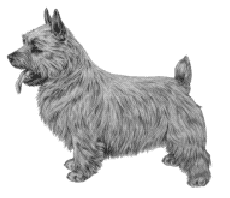Norwich Terrier
General Information - Norwich Terrier

Group:
Terrier
Size:
small
Lifespan:
13-15 years
Exercise:
moderate
Grooming:
moderate
Trainability:
moderate
Watchdog ability:
very high
Protection ability:
very low
Area of Origin:
England
Date of Origin:
1800s
Other Names:
none
Original Function:
Ratting, fox bolting
History
Short-legged Ratting Terriers have long been valued in England, but only in the 1880s did the breed that would eventually become both the Norwich and Norfolk Terriers emerge from obscurity. At that time, owning one of these small ratters became a fad among Cambridge University students. The little terriers became known as CanTab, and later Trumpington Terriers. Around 1900, a Trumpington Terrier named Rags came to a stable near Norwich and gained notoriety as a ratter as well as sire. He sired countless offspring and is the patriarch of the modern Norwich.
Temperament
The Norwich Terrier is a spunky little dog that loves to know what is going on, who is going to be there, and generally be the center of anything that is going on. Norwich Terriers get along with other pets and love to play with children.
Upkeep
The Norwich needs to stretch its legs with a good walk or short run every day. It especially likes combining a run with a chance to explore, but any such off-leash expeditions must be done only in a safe area. It is better suited as a house dog with yard access, but it can stay outdoors during the day if need be in temperate to warm climates. Its wiry coat needs combing one to two times weekly, plus stripping of dead hairs three to four times a year.
Norwich Terrier
A breed standard is the guideline which describes the ideal characteristics, temperament, and appearance of a breed and ensures that the breed is fit for function with soundness essential. Breeders and judges should at all times be careful to avoid obvious conditions and exaggerations, as well as being mindful of features which could be detrimental in any way to the health, welfare or soundness of this breed.
Breed Standard - Norwich Terrier
 Characteristics
Characteristics: The Norwich Terrier is one of the smallest of the terriers. Of a lovable disposition, not quarrelsome, tremendously active and with a hardy constitution. Temperament gay and fearless.
General Appearance: A small, low, keen dog, compact and strong with good substance and bone. Honourable scars from fair wear and tear should not be penalised unduly.
Head and Skull:Skull broad and slightly rounded with good width between ears. Well defined stop. Muzzle wedge shaped and strong. Ratio of muzzle length to skull length is 2:3.
Eyes: Small and oval shaped, dark, full of expression, bright and keen.
Ears: Erect, set well apart on top of skull. Of medium size with pointed tips. Held perfectly erect when aroused. Can be laid back when not at attention.
Mouth: Tight lipped, jaws clean and strong. Teeth strong, rather large. Scissor bite.
Neck: Neck strong of good length, commensurate with correct overall balance, flowing into well:laid back shoulders.
Forequarters: Legs short, powerful and straight; elbows close to body. Pasterns firm and upright. Legs should be moving straight forward when travelling.
Body: Short back, compact body with good depth. Rib cage should be long and well sprung with short loin. Level topline.
Hindquarters: Broad, strong and muscular, with well turned stifle. Low set hock with great powers of propulsion. Hind legs should follow in the track of the forelegs when moving, showing the pads and with hocks parallel.
Feet: Round, well padded and catlike. To point straight forward standing and moving.
Tail: Customarily docked to a medium length. Set on high to complete a perfectly level topline. Carried erect.
Coat: Hard, wiry and straight, lying close to the body with a thick undercoat. Longer and rougher on the neck forming a ruff to frame the face. Hair on head and ears short and smooth, except for slight whiskers and eyebrows.
Colour: All shades of red, wheaten, black and tan, or grizzle. White marks or patches are undesirable.
Size: Ideal height 25.4 cm (10 in) at withers. This ideal height should not be attained by excessive length of leg.
Faults: Any departure from the foregoing points should be considered a fault and the seriousness of the fault should be in exact proportion to its degree.
Note: Male animals should have two apparently normal testicles fully descended into the scrotum.
DNZ No 260
Copyright Dogs New Zealand
30 May 18
Any departure from the foregoing points should be considered a fault and the seriousness with which the fault should be regarded should be in exact proportion to its degree and its effect upon the health and welfare of the dog and on the dog’s ability to perform its traditional work.




